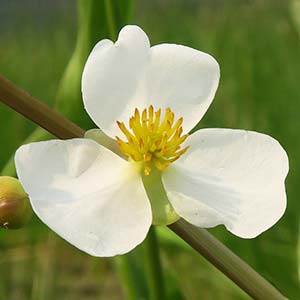Sagittaria latifolia
Sagittaria guayanensis
bird's-eye pearlwort, broad-leaf arrowhead, common arrowhead, duck-potato, Indian potato, sagittaire latifoliee, wapato
guyanese arrowhead
emersed;
petiole triangular, erect to ascending, 6.5–51 cm;
blade sagittate, rarely hastate, 1.5–30.5 × 2–17 cm, basal lobes equal to or less than remainder of blade.
racemes, rarely panicles, of 3–9 whorls, emersed, 4.5–28.5 × 4–23 cm;
peduncles 10–59 cm;
bracts connate more than or equal to ¼ total length, elliptic to lanceolate, 3–8 mm, delicate, not papillose; fruiting pedicels spreading, cylindric, 0.5–3.5 cm.
to 4 cm diam.;
sepals recurved to spreading, not enclosing flower or fruiting head;
filaments cylindric, longer than anthers, glabrous;
pistillate pedicellate, without ring of sterile stamens.
heads 1–1.7 cm diam;
achenes oblanceoloid, without abaxial keel, 2.5–3.5 × to 2 mm, beaked;
faces not tuberculate, wings absent, glands (0–)1(–2);
beak lateral, horizontal, 1–2 mm.
= 22.
Sagittaria latifolia
Sagittaria guayanensis
Sagittaria latifolia has been divided into numerous species and varieties. It was divided into two varieties, based upon the presence of pubescence over the entire vegetative plant (C. Bogin 1955; K. Rataj 1972). We have examined numerous specimens and found that many from the southeastern United States are pubescent; we believe that this character alone is insufficient for recognition of the varieties.
(Discussion copyrighted by Flora of North America; reprinted with permission.)
The name has often been spelled guyanensis (K. Rataj 1972), which is incorrect. Sagittaria guayanensis was the spelling in the protologue. The holotype was collected by Humboldt and Bonpland in Colombia, not Guyana. The type citation is Colombia: Guainia: in wetlands near the sugar mill of Don Felix Farreras and the city of Bolivar. The type is supposedly at Paris, as with all HBK types; however, we (with the help of Alicia Lourteig) have been unable to locate it. MO has a fragment, however. Rataj did designate a neotype: Suriname, Hostman 870 (TCD!). The fragment at MO takes precedence over this neotype.
Sagittaria guayanensis was divided into two subspecies, S. guayanensis subsp. guayanensis from the Neotropics and subsp. lappula (D. Don) Bogin from the Paleotropics. The two subspecies were separated by the shape and size of the fruit in addition to their distribution. Sagittaria guayanensis subsp. lappula has compressed achenes longer than 2.5 mm, whereas subsp. guayanensis has plump achenes shorter than 2.5 mm (C. Bogin 1955).
Subspecies 2 (1 in the flora).
(Discussion copyrighted by Flora of North America; reprinted with permission.)
- Local floras:
BC,
CA,
OR,
WA
- Local Web sites:
CalFlora,
CalPhotos,
Flora NW,
Go Botany,
IL Wildflowers,
KS Wildflowers,
LA Plants,
MD Biodiversity,
MI Flora,
MN Wildflowers,
MO Plants,
PNW Herbaria,
Turner Photog.
WildflowerSearch
iNaturalist (observations)
USDA Plants Database
- LBJ Wildflower Center
- SEINet
- Plants of the World Online
- Encyclopedia of Life
- Wikipedia
- Google Image Search
